








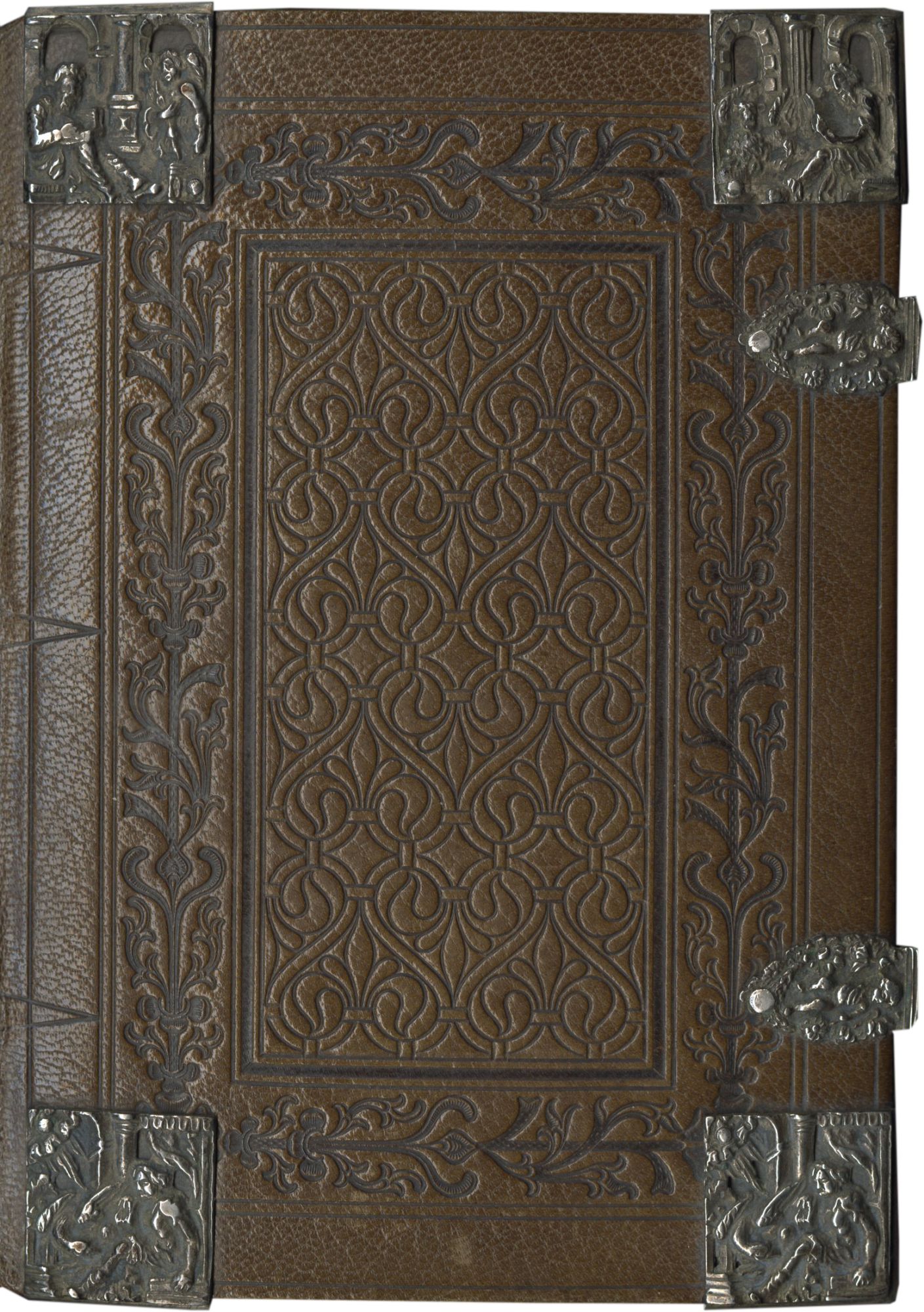
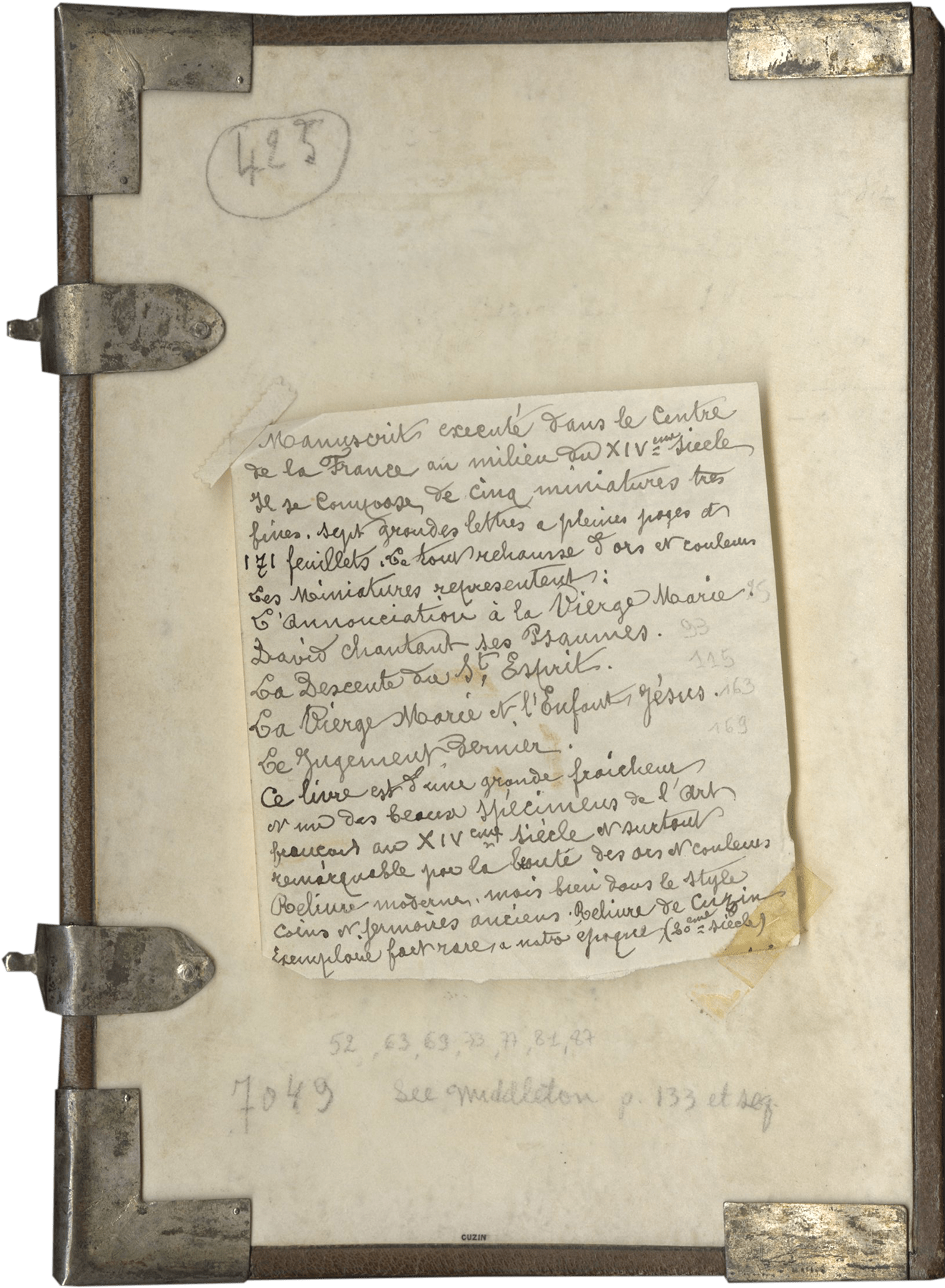

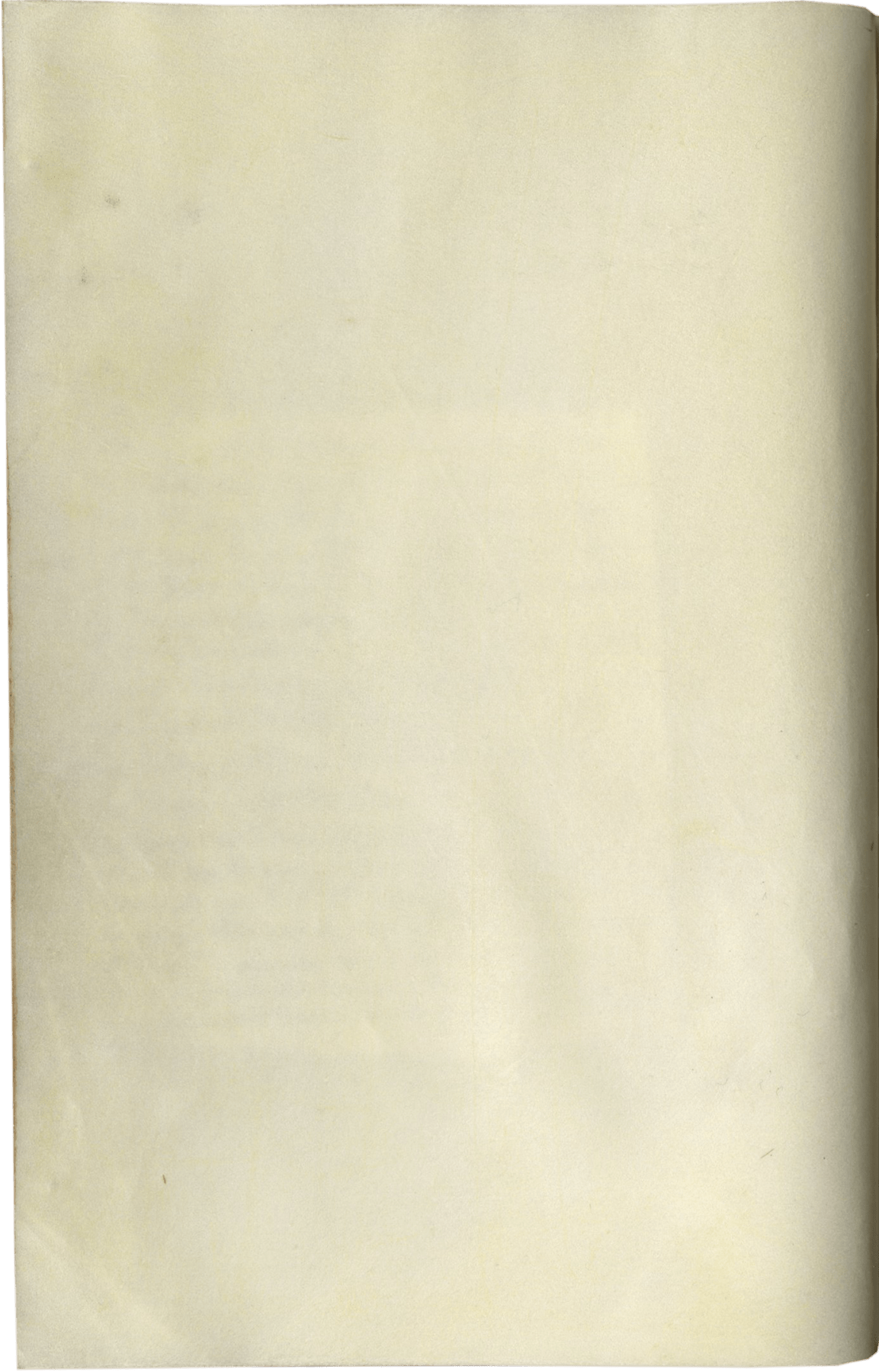
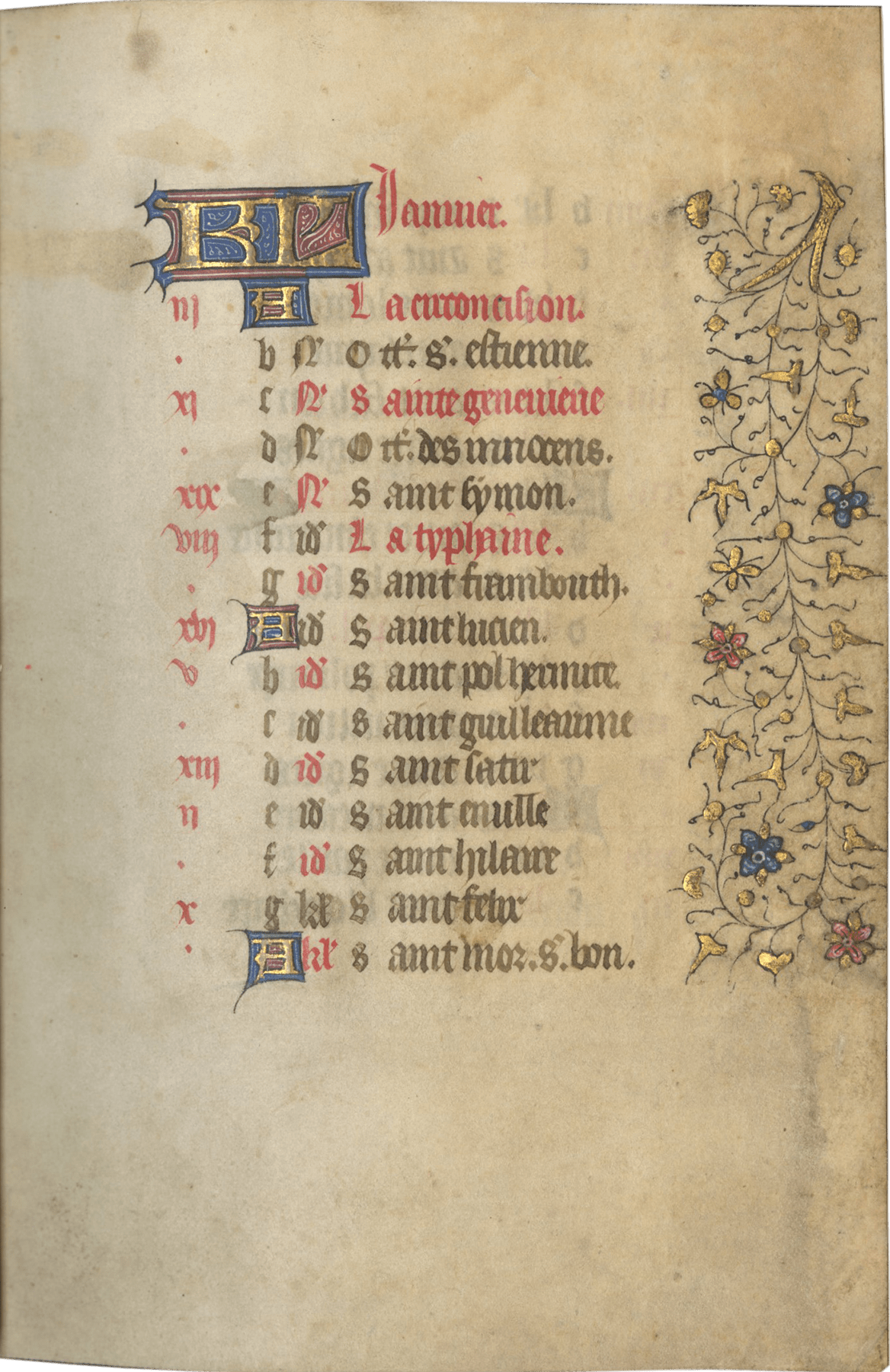





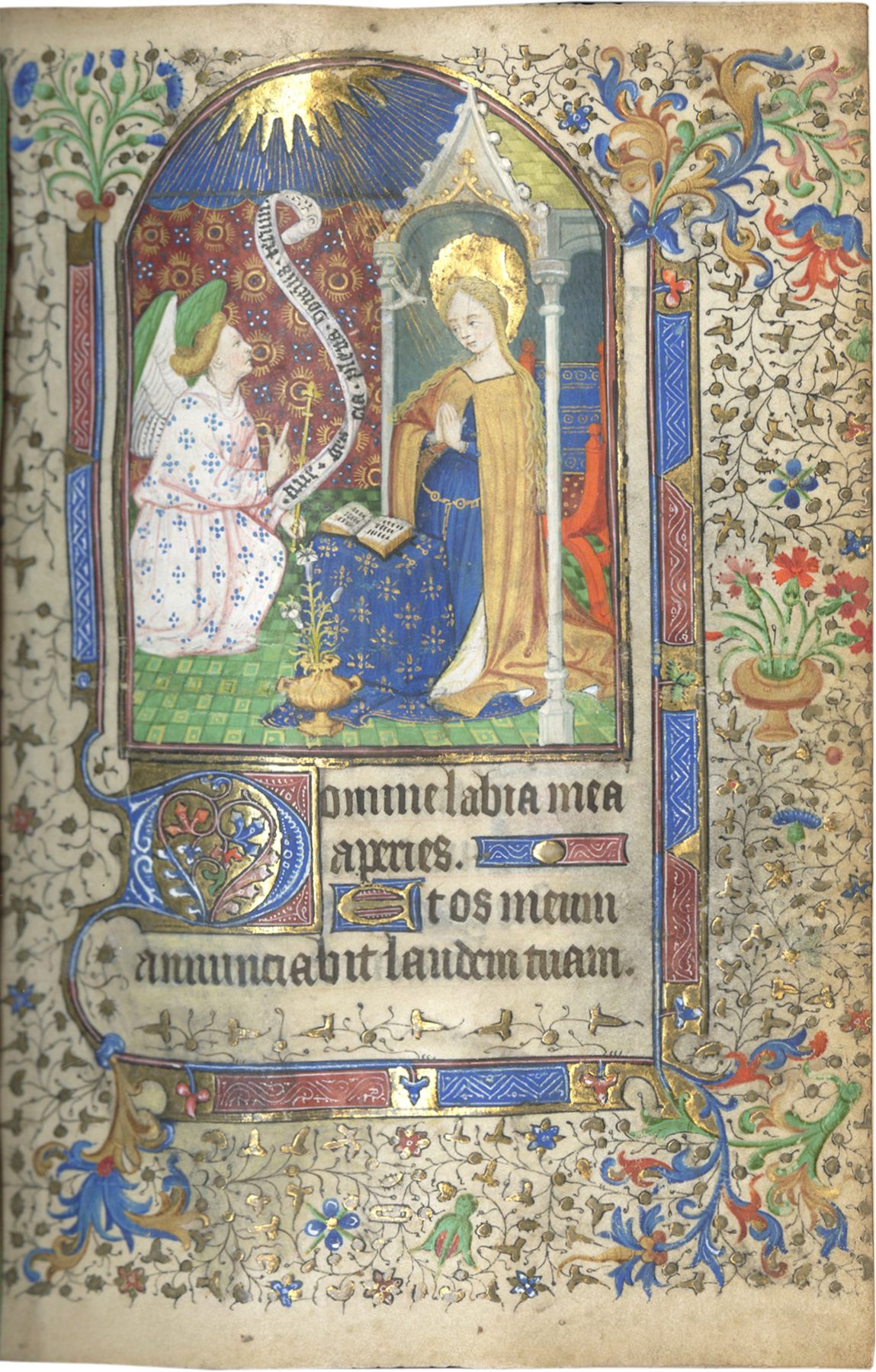


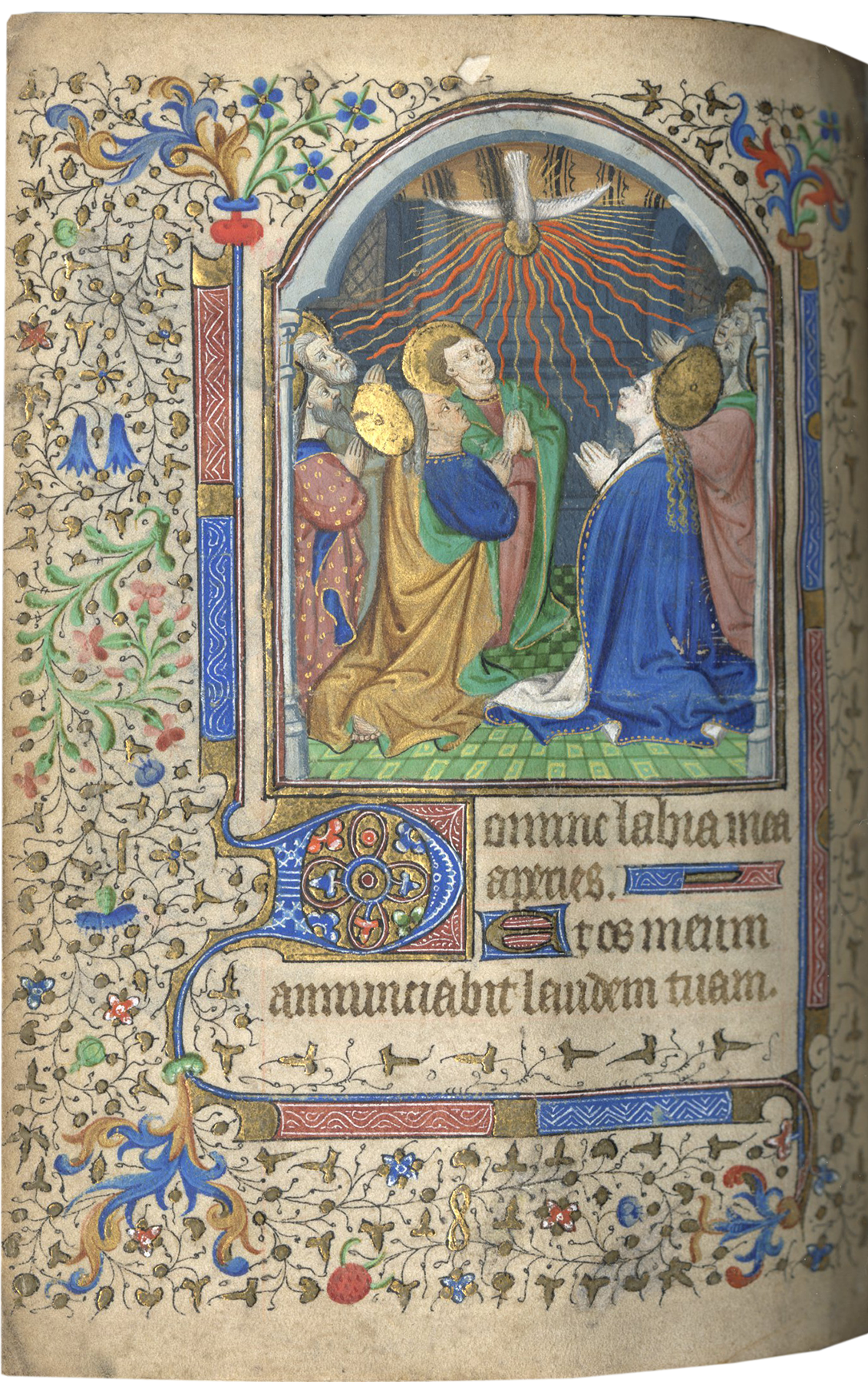



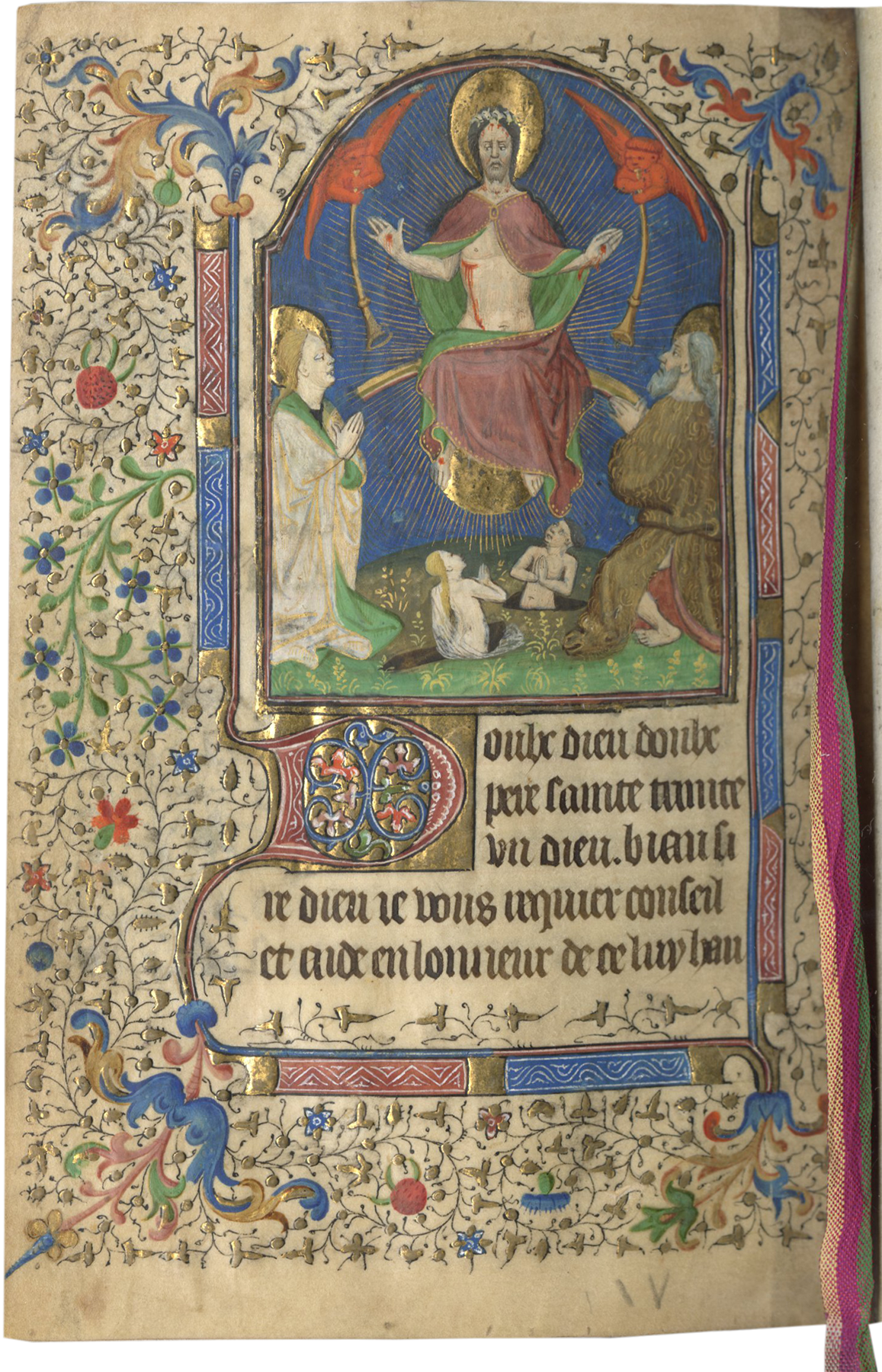

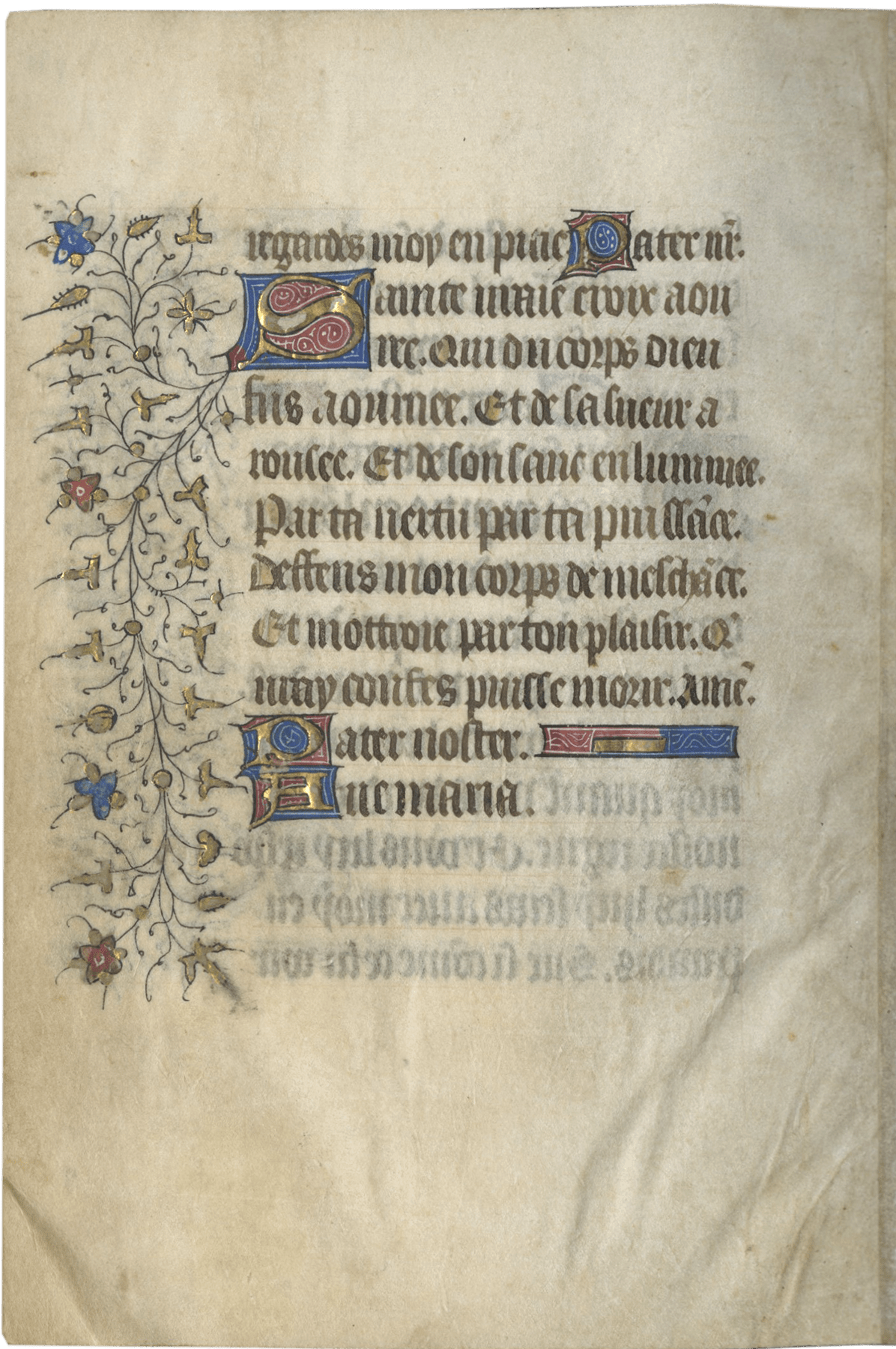
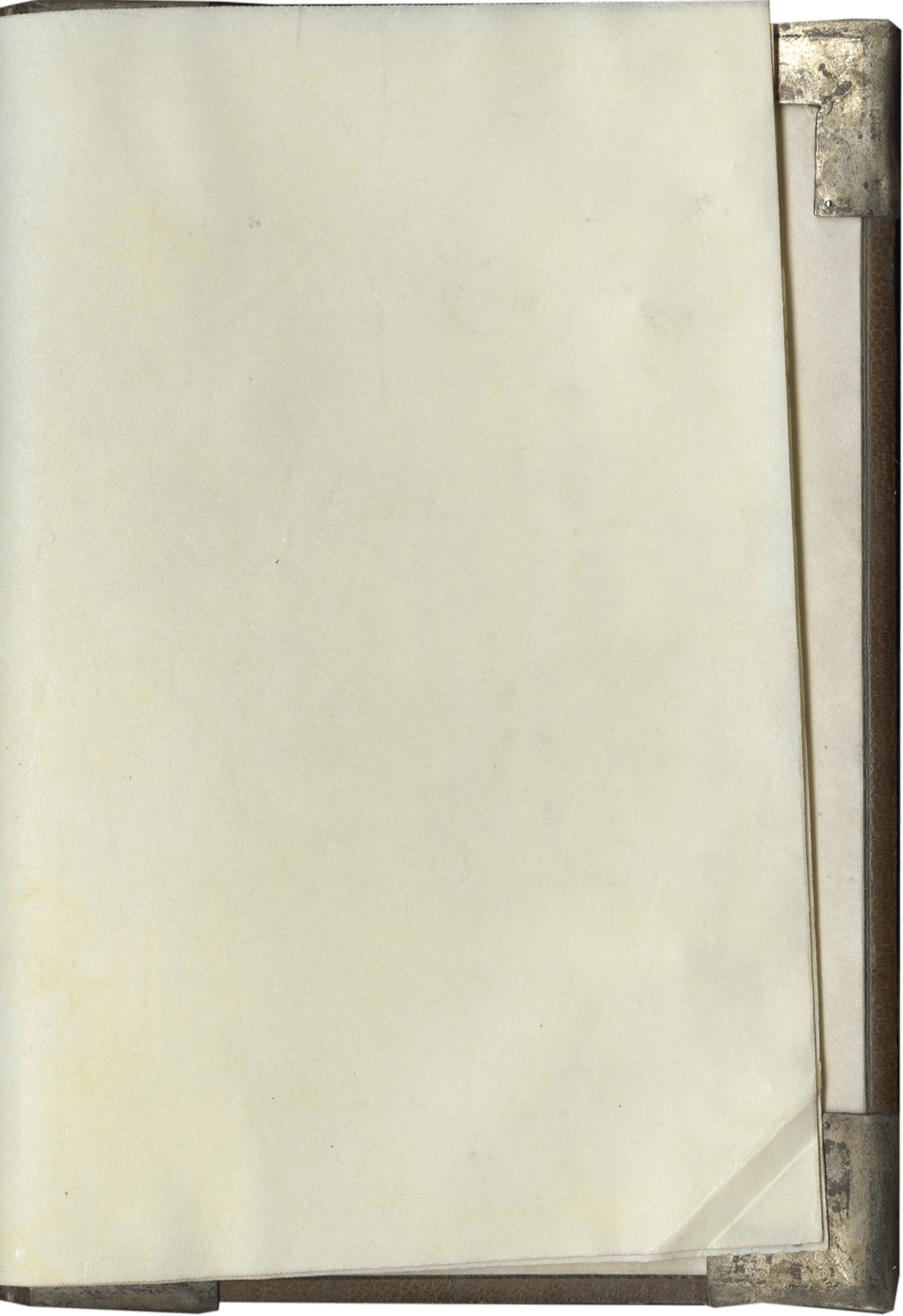
Description
This ravishing Book of Hours was commissioned in Paris around 1430 from the Master of the Munich Golden Legend and his workshop, one of the leading illuminators active in the French capital at the time of English occupation, most likely by a patron residing in Paris. Among its five miniatures, framed with full border of acanthus and gold ivy-leaves, three must be distinguished as remarkable examples of his sought-after style, distinguished by a subtle drawing of the faces, a bright palette of crisp colors evidenced in the garments, and delicate highlights in liquid gold. A nineteenth-century binding with neo-Gothic tooling and neo-Renaissance silver clasps and corners, depicting the Evangelists and putti, contributes to the charm of this typical example of mid-fifteenth century Parisian illumination.
ii (nineteenth-century parchment) +171 + ii (nineteenth-century parchment) folios on parchment, modern foliation in pencil every ten folios, 1-171, lacking two leaves with miniatures, otherwise complete (collation: i-iv6, v-ix8, x4, xi-xiii8, xiv2, xv-xvi8, xvii8 [-1, after f. 111, with miniature], xviii8 [-1, after f. 117, with miniature], xviii-xxii8, xxiii8 [+1, f. 171]), catchwords rubbed, ruled in red (justification 100 x 70 mm), written in brown ink in a formal gothic bookhand on fourteen lines, rubrics in red, line-endings in gold, red, and blue with white penwork, one- to three-lines initials in burnished gold on alternative red and blue ground with white penwork, side border in gold ivy-leaves with flowers in orange-red and blue on every leaf with text, four- to five-lines initials at the secondary textual sections in red or blue on burnished gold ground with floral infills, accompanied with a three-sides bar border in gold ivy-leaves with flowers and fruits, FIVE LARGE MINIATURES accompanied with a three-lines initial framed with gold and full border of gold ivy-leaves and acanthus sprays, in very good condition. Nineteenth-century brown crushed morocco binding with neo-Gothic ornamental tooling, attributed to Cuzin based on the eight neo-Renaissance silver corners depicting the four Evangelists on the upper and lower cover, and the two neo-Renaissance silver clasps depicting putti, gilt gauffered edges. Dimensions 180 x 125 mm.
Provenance
1. Stylistic evidence indicates that the present manuscript was commissioned by an unknown patron around 1430 from the Master of the Munich Golden Legend and his workshop, active in Paris from the early 1420s to the early 1450s. The Hours of the Virgin and the Office of the Dead were written for the liturgical use of Paris, while typical Parisian saints are mentioned in the calendar, with St. Genevieve, St. Louis, and St. Denis, as well as in the Litanies with St. Denis. The rather more unusual mention of St. Yves in the Litanies would have been appropriate for either a patron of Breton origin, or a member of Parliament.
2. The manuscript was in France in the late nineteenth and early twentieth century, considering on the one hand that its neo-Gothic binding with silver corners and clasps can be attributed to Francisque Cuzin (active in Paris, 1861-1890), and on the other hand that an old label pasted on the back of the upper cover is written in French.
3. European Private collection.
Text
ff. 1-12v, Calendar, use of Paris, with entries on every day in black and red, including St. Genevieve, St. Louis, and St. Denis in red;
ff. 13-18, Gospel Sequences;
ff. 18-21v, Obsecro Te, masculine form;
ff. 21v-25v, O Intemerata; f. 26-26v, blank, ruled;
ff. 27-92v, Hours of the Virgin, use of Paris;
ff. 93-111v, Penitential Psalms, followed with litany, ff. 106v-109, including St. Louis and St. Yves;
ff. 112-114, Short Hours of the Cross, lacking the beginning;
ff. 114v-117v, Short Hours of the Holy Spirit;
ff. 118-162, Office of the Dead, use of Paris, lacking the beginning;
ff. 162v-168, Fifteen Joys of the Virgin, in French, incipit, Doulce dame de misericorde;
ff. 168v-171v, Seven Requests of the Lord, in French, incipit Doulx dieu.
Illustration
Five large miniatures, as follow:
f. 27, Annunciation;
f. 93, David in Prayer, the border slightly darkened due to use or exposure;
f. 114v, Pentecost;
f. 162v, Virgin and Child in an enclosed garden;
f. 168v, The Last Judgment.
Introducing the main sections of the Book of Hours, the large miniatures can be attributed to the Master of the Munich Golden Legend and his workshop, named after a manuscript in the Bavarian State Library in Munich (CGM 3) that contains a French translation of Jacobus of Voragin’s Legenda aurea. One of the leading masters active in the late workshop of the Bedford Master, the Master of the Munich Golden Legend contributed to many of the great manuscripts produced under English occupation, such as the Hours of Bedford itself (London, British Library, Add. MS 18850) and the Sobieski Hours at Windsor Castle. He pursued his career throughout the early 1450s, illuminating a great number of manuscripts for a varied clientele living in Paris and beyond (for a recent list, see Clark 2016, pp. 298-304). In 2011, Eberhard König and Heribert Tenschert suggested to identify him with a Conrad of Toul, based on an apparent signature in the Munich volume, although no illuminator of that name appears in the known records of the Parisian book trade. The Master of the Munich Golden Legend may have worked on panel paintings as well as being a successful manuscript illuminator, if Eleanor Spencer was correct in attributing him a large panel depicting Jouvenel des Ursins and his family (Paris, Musée de Cluny, Inv. 9618), painted between 1445 and 1449 for their chapel in Notre-Dame cathedral, Paris.
Characteristic of the Master of the Munich Golden Legend’s style are the three remarkable miniatures of the Pentecost, the Virgin and Child in an enclosed garden, and the Last Judgment. Typical of his hand are the subtle drawing of the faces with large foreheads and bulbous noses, the bright palette of crisp colors, and the delicate highlights of liquid gold enlivening the draperies and grounds. On the other hand, the miniatures of the Annunciation and David in Prayer were entrusted to a member of his workshop, whose style, albeit more refined, is reminiscent of the Talbot Master active in Rouen. Despite the stylistic differences, these five miniatures rely on models commonly found in manuscripts illuminated in the workshop of the Master of the Munich Golden Legend around 1430.
A fine example is offered by a Book of Hours for the use of Paris in Chantilly (Musée Condé, MS 70; Ungeheuer 2015, pp. 686-688; Clark 2016, p. 330), which offers a nearly identical layout of the bar borders and secondary decoration. Also comparable is the composition of the Last Judgment, introducing the Seven Requests to the Lord. In both manuscripts, the Christ judge appears seated on a gold rainbow with the feet on a gold sphere, between two cherubs playing the trumpet, while two resurrected souls are seen below, between the Virgin and St. John Baptist. The figure of the Christ judge already appeared in a miniature added c. 1425 in the Hours of the Neville family (Paris, BnF, MS lat. 1158, f. 35). The miniature of David in Prayer, dressed with a pink mantle over a blue robe, kneeling in prayer with his harp on the grass, is also reminiscent of other examples of the same theme. These include a Book of Hours illuminated by a member of his workshop around 1430 in Collegeville, Minn. (Hill Museum & Library, MS Bean 2), whose style may also compare to the Annunciation of the present manuscript. A later example, due to the Master of the Munich Golden Legend himself, is found in the Hours of Isabeau de Croix, sumptuously illuminated in the early 1440s alongside the Master of the Harvard Hannibal and the Dunois Master’s workshop (formerly Les Enluminures; now Private Collection).
Literature
König, Eberhard and Heribert Tenschert. Das pariser Stundenbuch an der Schwell zum 15. Jahrhundert, Ramsen, 2011.
Clark, Gregory T. Art in a Time of War. The Master of Morgan 453 and Manuscript Illumination in Paris during the English Occupation (1419-1435), Toronto, 2016.
Ungeheuer, Laurent. “Le Maître de la Légende dorée de Munich. Un enlumineur parisien du milieu du XVe siècle, formation, production, influences et collaborations,” Unpublished Doctoral Dissertation, Paris, 2015.
Ungeheuer, Laurent. “Le Maître de la ‘Légende dorée’ de Munich, un émule du Maître de Bedford: collaboration et indépendance d’un enlumineur parisien entre 1420 et 1450,” Revue de l’art 195 (2017), pp. 23-32.
Spencer, Eleanor. The Sobieski Hours. A Manuscript in the Royal Library at Windsor Castle, London and New York, 1977.